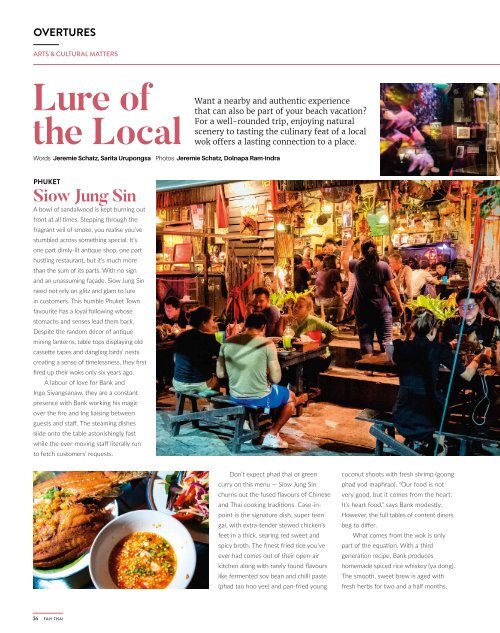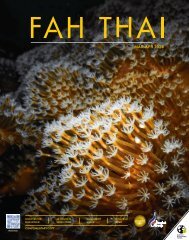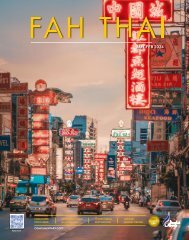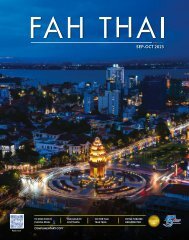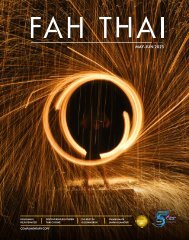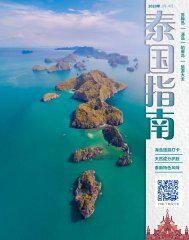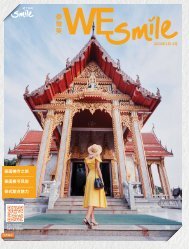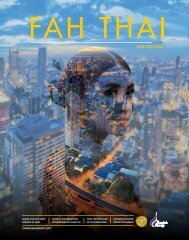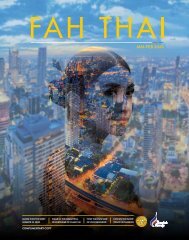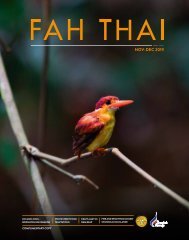Fah Thai Magazine Jul-Aug 2018
Read FAH THAI MAGAZINE Online! Fah Thai is the inflight magazine of Bangkok Airways. We also come in a digital format. You can read us at Fahthaimag.com
Read FAH THAI MAGAZINE Online! Fah Thai is the inflight magazine of Bangkok Airways. We also come in a digital format. You can read us at Fahthaimag.com
Create successful ePaper yourself
Turn your PDF publications into a flip-book with our unique Google optimized e-Paper software.
OVERTURES<br />
ARTS & CULTURAL MATTERS<br />
Lure of<br />
the Local<br />
Words Jeremie Schatz, Sarita Urupongsa Photos Jeremie Schatz, Dolnapa Ram-Indra<br />
PHUKET<br />
Siow Jung Sin<br />
A bowl of sandalwood is kept burning out<br />
front at all times. Stepping through the<br />
fragrant veil of smoke, you realise you’ve<br />
stumbled across something special. It’s<br />
one part dimly-lit antique shop, one part<br />
hustling restaurant, but it’s much more<br />
than the sum of its parts. With no sign<br />
and an unassuming façade, Siow Jung Sin<br />
need not rely on glitz and glam to lure<br />
in customers. This humble Phuket Town<br />
favourite has a loyal following whose<br />
stomachs and senses lead them back.<br />
Despite the random décor of antique<br />
mining lanterns, table tops displaying old<br />
cassette tapes and dangling birds’ nests<br />
creating a sense of timelessness, they first<br />
fired up their woks only six years ago.<br />
A labour of love for Bank and<br />
Ingo Siyangsanaw, they are a constant<br />
presence with Bank working his magic<br />
over the fire and Ing liaising between<br />
guests and staff. The steaming dishes<br />
slide onto the table astonishingly fast<br />
while the ever-moving staff literally run<br />
to fetch customers’ requests.<br />
Want a nearby and authentic experience<br />
that can also be part of your beach vacation?<br />
For a well-rounded trip, enjoying natural<br />
scenery to tasting the culinary feat of a local<br />
wok offers a lasting connection to a place.<br />
Don’t expect phad thai or green<br />
curry on this menu — Siow Jung Sin<br />
churns out the fused flavours of Chinese<br />
and <strong>Thai</strong> cooking traditions. Case-inpoint<br />
is the signature dish, super teen<br />
gai, with extra-tender stewed chicken’s<br />
feet in a thick, searing red sweet and<br />
spicy broth. The finest fried rice you’ve<br />
ever had comes out of their open-air<br />
kitchen along with rarely found flavours<br />
like fermented soy bean and chilli paste<br />
(phad tao hoo yee) and pan-fried young<br />
coconut shoots with fresh shrimp (goong<br />
phad yod maphrao). “Our food is not<br />
very good, but it comes from the heart.<br />
It’s heart food,” says Bank modestly.<br />
However, the full tables of content diners<br />
beg to differ.<br />
What comes from the wok is only<br />
part of the equation. With a third<br />
generation recipe, Bank produces<br />
homemade spiced rice whiskey (ya dong).<br />
The smooth, sweet brew is aged with<br />
fresh herbs for two and a half months.<br />
It’s meant to drink before eating, but<br />
typically continues throughout the meal<br />
and into the night. Bank has colloquially<br />
named it “the swan that never meets the<br />
target,” the meaning of which is open<br />
to interpretation.<br />
If you have an empty stomach and<br />
are on the prowl for a uniquely authentic<br />
Phuket experience, find your way to Siow<br />
Jung Sin. Siow Jung Sin, Wirat Hong Yok<br />
Rd, Tambon Talat Nuea, Amphur Muang,<br />
Phuket, Phuket<br />
KRABI<br />
Wat Tham Suea<br />
Travellers looking to nurture their inner adventurer<br />
will want lace up their walking shoes and explore<br />
Wat Tham Suea, also referred to as the Tiger<br />
Cave Temple.<br />
Nestled in the shadow of a towering<br />
limestone peak on the edge of a verdant valley<br />
10km outside Krabi Town, this temple complex<br />
attracts a diverse group of visitors. Established<br />
in 1975 by Buddhist monks, there are several<br />
versions of an origin story including tiger paw<br />
prints being discovered on the cave wall, an<br />
enormous tiger residing in the cave, and most<br />
plausible, a healthy population of tigers roaming<br />
the surrounding jungle.<br />
Although named for the limestone cave, the<br />
leading attraction is undoubtedly the mountaintop<br />
Buddha and Chedi (Stupa). To reach the summit<br />
one must climb a precipitous staircase of 1,260<br />
steps. Although mostly shaded, it is quite strenuous<br />
and an early start is recommended. A comfortable<br />
pair of shoes and a generous supply of drinking<br />
water are mandatory. You are unlikely to be alone<br />
as troops of monkeys loiter around the steps and<br />
bathe in the cistern at the top. Beware of your<br />
unattached belongings as daring, naughty monkeys<br />
just might want to rid you of them. However, it’s<br />
all worth it as those who brave the primates and<br />
muscle through the arduous ascent are rewarded<br />
with a jaw-dropping 360-degree view of the<br />
surrounding landscape.<br />
After a much-deserved rest and descent<br />
from the mountain, be sure to locate the other<br />
staircase further back in the complex which leads<br />
over a small ridge and into an isolated, jungle-filled<br />
area where the resident monks live. A trail leads<br />
past a sprawling altar, along the foot of a cliff<br />
where the monks’ humble abodes perch in<br />
indentations in the rock. It continues in a loop<br />
through a prehistoric-feeling jungle.<br />
One can easily spend the better part of a day<br />
at Wat Tham Suea climbing the mountain, hanging<br />
out with monkeys, and exploring all of the temples.<br />
Who said you have to be lazy on vacation!<br />
36<br />
37


